Corporate Research Associates issued a correction to its latest polling numbers for Newfoundland and Labrador on Monday and the result is truly startling.
The Conservatives under Kathy Dunderdale have the support of 56% of voters compared to 51% for the Tories under Danny Williams in November 2010.
Sure her personal popularity may be less than Danny’s but she’s managed to pull the Tories out of their downward slide in Danny’s last three months that took them from 61% in August to 51% in November. Dunderdale’s started the Tories back on the path to the stars and without doing very much of anything for the past three months except fend off a weak challenge to her leadership by Brad Cabana.
Not surprisingly, the Conventional media are following along with CRA’s news release and their own conventional wisdom to make the poll numbers fit what they think the numbers should say. They are saying that Dunderdale is not as strong as Danny but she is still pretty big.
But as absurd as it may seem, the CRA numbers really put Kathy ahead of her old patron.
According to CRA’s revised numbers, undecideds dropped from 31% to 23% in the three months or so Danny’s been gone. The unfiltered, undistorted CRA numbers show Tory support went from 51% in November with Danny as leader to 56% with Kathy Dunderdale.
Both the change in party support for the Tories and the change in undecideds is outside the margin of error (4..9 percentage points)
“How could this be?” you are likely asking.
Call it the mother of all typos.
The original news release included this sentence:
Those with no stated preference included those who were undecided (18%), do not plan to vote (3%), or refuse to state a preference (18%).
That adds up to 39%.
The table at the end of the news release gave the figure as 23%. Apparently that second 18% was only supposed to be two percent.
Not 18.
2.
Big difference.
It’s a bit of a head scratcher as to how someone could mistakenly type “18” instead of “2” and how the release could get out the door with such a glaring error.
Your humble e-scribbler took the figures in the text of the release in largest part since they were consistent, across the board with a similar poll done by NTV/Telelink in February. Those are the figures used in an earlier post.
Now what we are left with is a poll that mirrors Telelink in every way except in Conservative support and the level of undecided/no answer and will not votes. The differences are hardly inconsequential.
What this cock-up really should be is a reminder that CRA’s poll reporting does contain some rather glaring problems. For instance, CRA routinely distorts the results of its polls by presenting only the results for decided voters. You can see the effect of that misrepresentation by charting the results as a share of all responses, not just the “decideds”. This chart is taken from post last December on CRA’s fourth quarter poll.
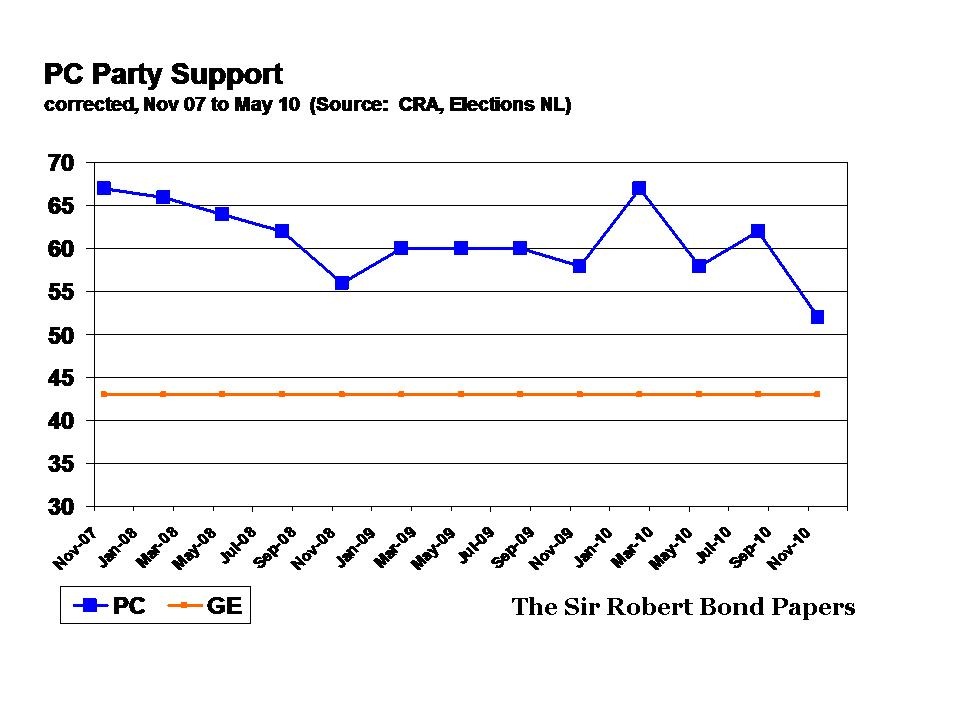
According to CRA’s version, the Conservative party’s support remains in the mid 70s. What doesn’t get noticed is that the “undecided” category has gone from the teens to 31% in November 2010. Now it’s dropped again to 23% in the most recent poll.
You’ll also see in the middle of that chart another clue that something is seriously wrong with CRA’s polls. That flat line in the middle would be a period of three consecutive quarterly polls where the difference in Tory support was apparently less than one percent. Those interested in a more detailed discussion can find it in an older post: There’s a fairly lengthy post that discusses most of the major problems with CRA polling: “How the Tories get 28% more votes thanks to CRA”..
For the first time in a long while, CBC has added a few questions to CRA’s quarterly polling. Ostensibly they give new information, but essentially, CBC just gives a variation on the basic horse race questions. One of the CBC questions even repeats the same flawed question format of “mostly” and “completely” and equally extreme negative choices. On other occasions, incidentally, CRA has asked a typical five point Likert scale (strong and moderate positives and negatives with a neutral) and reported the results as “completely” or “mostly” as appropriate.
What is the difference, after all, between completely and mostly, compared to completely and somewhat? think about it for a second and you’ll get the point.
What’s missing in all the questions is the sort of stuff that would give any indication of what Newfoundlanders and Labradorians are concerned about. What pollsters typically do is ask what issues are of concern to their respondents. Then they might ask voters to rate party performance on each question. Sometimes they might leave out the party support questions so as not to unduly influence the responses, but with or without it, one can get a much better sense of what potential voters are thinking.
Instead of some insight, one gets absurd responses. For example, when asked whether Williams departure will influence party choice (the question itself is oddly worded, by the way), 34% said they were less likely to vote Conservative while 30% said they are more likely.
Huh?
Exactly.
And don’t forget the Conservatives supposedly enjoy 73% voter support - using CRA’s own method of reporting - with only 18% actually undecided in their party choice.
And as a last point, let’s just remember this basic point. CRA polls eligible voters. They don’t screen for usual voters or regular voters. They just survey all eligible voters. That means you need to compare their poll results, including UND/DK/NA with the actual poll results for any given election.
In their Fall 2007 quarterly survey, CRA put the combined no answer/will not vote/undecided at a mere 18%. The actual result on polling day was 38%. CRA’s quarterly polls typically show that the “will not vote” category is less than five percent.
-srbp-
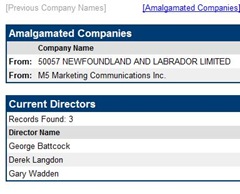 It’s also interesting that while CBC mentioned a relationship between MQO and advertising company M5, they didn’t mention that MQO is also Nalcor’s pollster because it is owned by M5. The advertising company is Nalcor’s agency of record.
It’s also interesting that while CBC mentioned a relationship between MQO and advertising company M5, they didn’t mention that MQO is also Nalcor’s pollster because it is owned by M5. The advertising company is Nalcor’s agency of record.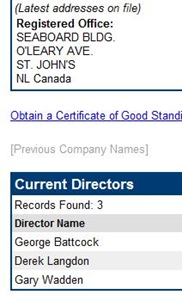 CBC also said MQO was “affiliated” with M5. That’s not even close to correct either.
CBC also said MQO was “affiliated” with M5. That’s not even close to correct either. 

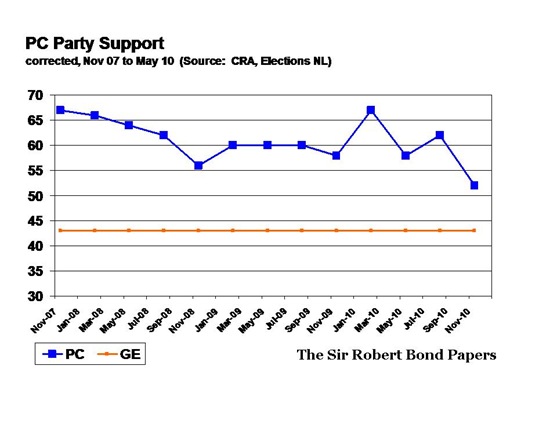
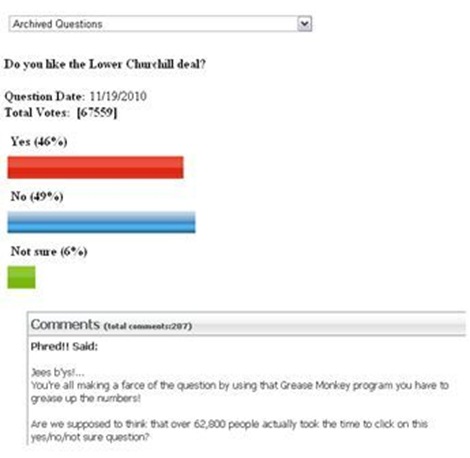

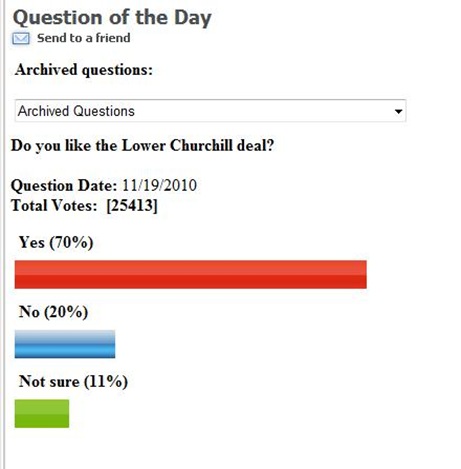
![qotd20nov1030[4] qotd20nov1030[4]](http://lh3.ggpht.com/_1JCeohwjuLE/TOiQlQOtWwI/AAAAAAAACnw/rdrOZzfMLiM/qotd20nov1030%5B4%5D_thumb%5B3%5D.jpg?imgmax=800)



